In Paris, like eating at grand-mere’s
March 8, 2009 - The Boston Globe - Travel
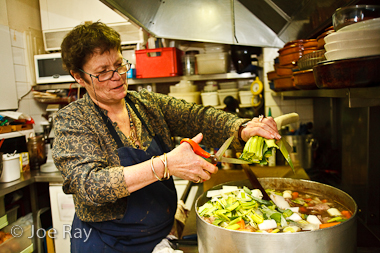
PARIS—La Mère Agitée looked promising before I got there: The tiny restaurant’s website features a photo of the contents of a saucepan being submerged in a stream of heavy cream. Next to the photo is the claim: “best pig’s head in the world since 1995.”
Likewise, an artist’s palette in a display window outside Chez Lucette reads “traditional cuisine made without microwave ovens,” “little dishes, simmered with care,” and, even better, “pontiffs and grumps stay away.”
Ask most Parisians - even those in the know - if la cuisine traditionnelle made and often
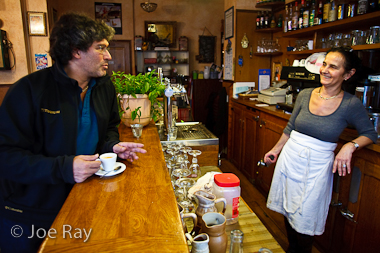 At Chez Mamy in the 11th arrondissement, a customer chats with Pauline Clavel, who owns the restaurant with her daughter.
At Chez Mamy in the 11th arrondissement, a customer chats with Pauline Clavel, who owns the restaurant with her daughter.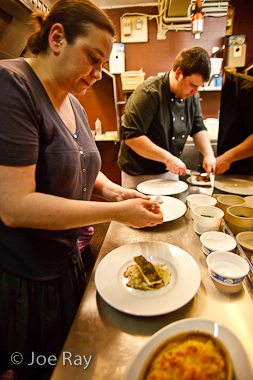 Nadège Varigny at her restaurant, Ribouldingue. “I like people
Nadège Varigny at her restaurant, Ribouldingue. “I like people
who like to eat. I like getting them to try things,” she says.
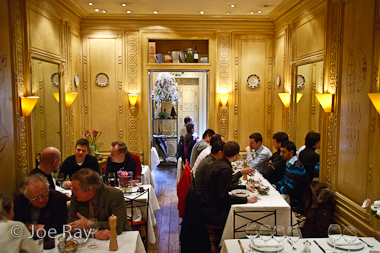 Diners inside Ribouldingue (above)... whose neighbor (below) is Notre Dame.
Diners inside Ribouldingue (above)... whose neighbor (below) is Notre Dame.
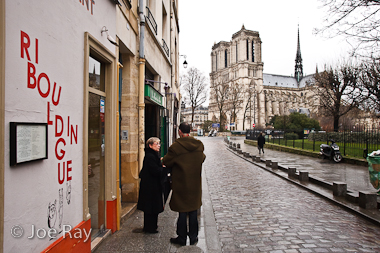
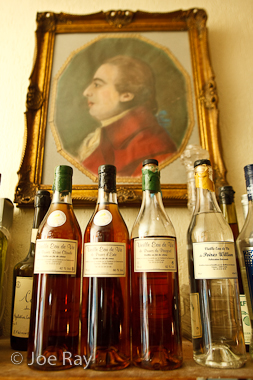 Bottles of eau de vie at La Mère Agitée.
Bottles of eau de vie at La Mère Agitée.delivered to your table by what the French would call a dame d’un certain age still exists in the City of Light, and they will probably give a nostalgic sigh.
Luckily, a handful of these places, perfect in their ability to make you feel as if you’re eating at Grandma’s, are still here. Combine fantastic comfort food with a gentle price tag - and the feeling that you are both being cared for and part of something greater - and you have got something incredibly well-timed for a sagging economy.
“Right now, people want a sure thing - they want the recipes of their grandmothers,” says Valerie DeLahaye at La Mère Agitée.
Part of DeLahaye’s philosophy became clear the first time I ate at her 14th arrondissement bistrot. Arriving very late for a group dinner, I asked whether I could have a pitcher of wine, and she pointed at a half-full bottle of red on a nearby table and said, “Take that one.”
“I’m in a niche,” she explains. “It’s not expensive here. At 35 euros with wine, you know coming in that you’re not going to drop more money on a bottle. I’ll even throw in an apéro.”
La Mère Agitée has no fixed menu; you eat what DeLahaye makes on a given night. She says this as she prepares a salad topped by toast squares with duck rillettes that will be followed by a classic blanquette de veau and, in honor of its recently-deceased creator, Gaston Lenôtre, an Opéra - thin layers of almond bread coated with coffee cream and chocolate frosting.
“And tomorrow?” I say, thinking she’ll explain the next day’s dishes.
“An homage to Louis XIV!”
It turns out that the first Wednesday of every month, a group of friends get together at her restaurant to sing old French songs, and tomorrow’s meeting honors the Sun King.
“This is the only restaurant in Paris where we sing songs this old,” says Jacques Arnold, a friend and client of DeLahaye who has stopped by to finish composing a new song for the homage.
“We’re unclassifiable here, we’re all friends and all kinds of people come through the door, ” he says, gesturing around the dining room, “but we’re all brought together by Valerie’s magic.”
Back in the kitchen, that magic is taking shape with several heads of red cabbage. DeLahaye cuts up the cabbage, transfers it to a large pot, and adds a bottle of vinegar, a few handfuls of salt, a shot of water, a little bucket of honey, and a jar of her mother’s homemade apple jelly. Le coup de grace? Two snow-white bricks of pork fat.
“I’ll let that bubble away for five or six hours tomorrow,” she says, with a grin that would make a French monarch proud.
Though there are wooden spoons marked “sweet” and “savory” in her cluttered kitchen, there are no measuring cups to be seen. When I ask where they are, she scrunches up her face and says, “I only use them when I bake.”
“When I was 3, I knew I’d have a restaurant. At 5, I got a book from my grandmother called ‘Cuisine Est Un Jeu d’Enfant’ (‘Cooking Is Child’s Play’). Now, I’m 51 . . . and a half,” she says, and when she catches me smiling at her playful honesty, she adds, “That’s my childish side. I keep that.”
Back in the dining room is Yves de Saint Front who, like his father, was a painter and a navigator. He’s here with friends and family, including his son, a hermit in the mountains of Tahiti, who is home for the first time in eight years.
“When I sailed with my father we went everywhere - Spain, Tahiti . . . ,” says Saint Front, “he’d like it here.”
“Cooking is happiness,” says DeLahaye. “Cooking is sharing human warmth.”
What you get at these matron-run restaurants that, particularly as a visitor, you might not get anywhere else in Paris, is that human touch. Parisians can have a rough, off-putting exterior that’s hard to break through and restaurants like these - for visitors and locals alike - can be a place to connect.
“This is a meeting place,” says the owner and chef at Chez Lucette in the 17th arrondissement who identifies herself simply as Rose. “When people are having a tough time, they come here. They want the exchange.”
The real price of membership at the restaurant locals call simply Chez Rose is acceptance of the Golden Rule. “When people come here, they accept the other,” she says. “They integrate themselves in the atmosphere . . .” she trails off for a moment and smirks, then adds, “or I kick them out.”
Sure enough, everyone seems to know everyone in her restaurant. On any given night, it could be a couple of tables of blind people, Alsatian accountants in town for a conference who have found the restaurant through word of mouth, or the woman who comes in every night for a plateful of shrimp and a pitcher of wine. Clients are addressed by their first names and Rose knows who’s looking for an apartment, trying to sell their car, or just in need of a spiritual pick-me-up, which she generally remedies with an ear-splitting kiss of greeting on each cheek.
Like at La Mère Agitée, Rose tells customers what she’s cooking that day. It could be steak and fries that she cuts to order, farm-raised chicken, or leg of lamb. At the end of a meal, it might be a homemade crepe or tarte Normande so good it’s wise to reserve your piece when you walk in the door. (I was nearly blacklisted from Chez Rose when, thinking she didn’t have time to do it all by herself, I asked where she got one of her desserts.)
“If the food is good, it creates a sort of relaxation,” she says. “It brings people down to earth and shows there’s more to life. It’s not like you’re shooting the breeze at a bar - it’s more profound. Here, we get down to the essentials.”
At these restaurants, there is inevitably a switch from talking about the daily grind to talking about life - anything from a granddaughter’s upcoming trip to a US summer camp, to the best way to cook pot au feu, to a slowly-dying husband.
“I thought this species had disappeared,” says Christian Millau, co-founder of the Gault-Millau restaurant guides and a legend in French food circles. “These places are based on simple and innocent feelings: that the woman will be honest, do her own shopping, and cook without the arrogance of male chefs. These women are cooking because they learned from their mothers,” he adds. “They treat their clients like their children. They have a strong and affective link with them.”
Hidden in the shadow of Notre Dame, just around the corner from the famous Shakespeare and Company bookstore, is the wild card of the group: Nadège Varigny, at the Ribouldingue restaurant. At 40, she’s the spring chicken, neither grandmotherly nor the one cooking the food, yet one of the best examples of the heart and soul of these restaurants. When you eat at Varigny’s restaurant there’s no doubt about who is in charge.
“I’ve got an eye on everything. You have to. I used to let the chef run the show, but now I govern,” she says.
As the daughter of generations of butchers and bonnes femmes from the southeastern department of Isère, Varigny was taught to love and appreciate traditional French cuisine.
“We sell what we love. I can’t deal with stuff I don’t like,” she says. “I can’t stand bad wines or paying too much.”
Traditional, yes, but not all dishes here are for the faint of heart. Since opening in 2006, Ribouldingue has become a reference address for what the French call the “noble parts” - offal dishes like tête de veau, sweetbread, and tripe.
“When you come here, you eat an appetizer, main dish, and a dessert - not just a main course,” Varigny says. “I want to create a place for bon vivants who love to eat.”
On this day, a group of health care specialists (gland experts, no less) have set up camp for a long, lingering lunch, and at the table, a tiny woman scoops marrow from a roasted bone larger than any in her body.
“I like people who like to eat,” Varigny says. “I like getting them to try things,” and even more than that, as the 12-year front of house manager for star chef Yves Camdeborde’s former restaurant, La Régalade, she is expert at setting up an eater’s atmosphere.
“I loved working there - I learned so many things, like not letting stuff get under your skin,” she says, “but mostly, that it’s got to be perfect. It’s your place.”
IF YOU GO
Where to eat
La Mère Agitée
21 rue Campagne-Première
011-33-1-4335-5664
http://www.lamereagitee.fr
Eat well, drink well, linger and sing along to old French songs if you’re here on the first Wednesday of the month. Meals about $44, wine and an apéro included.
Chez Lucette
43 rue de la Jonquière
011-33-1-4627-7254
Your jaw might drop after your first taste of the tarte Normande. Dinners around $38.
Ribouldingue
10 rue Saint-Julien-le-Pauvre
011-33-1-4633-9880
For those hesitant about the (fantastic) offal specialties served here, fear not - the classic offerings are just as good. Fixed-price lunch and dinner menus about $36, plus wine.